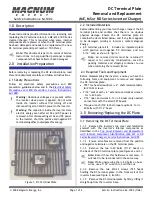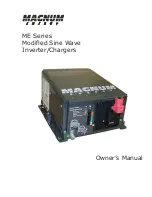
VANNER
Incorporated
OWNER’S MANUAL
Vanner High Voltage DC-
DC Converter OWNER’S MANUAL
17
Trouble Shooting an HBA No-Start Situation
In the event the Vanner HBA does not start, the following need to be reviewed/validated;
1. Is the high voltage battery within the acceptable input range? 550 - 780VDC
2. Is the 24V battery within the acceptable range? 20
– 32VDC
3. Is 24V battery voltage present at the output terminals of the HBA upon closing the battery disconnect
switch?
4. If not, verify the fuse between the 24V battery and the HBA
is installed and hasn’t cleared.
5. Upon startup of the engine, does the 24V battery remain within the acceptable range? If the health of
the 24V batteries is questionable, the voltage may collapse below 20 volts before the HBA starts.
There is an approximate 2 - 3 second delay from the time the engine starts to the start of the HBA.
6. Is the +24V enable signal present at the I/O connector?
7. If the +24V enable signal is present, is the wire in the proper location of the mating I/O connector?
8. For vehicles with pre MY2013 engines: Is the engine rpm data being transmitted properly via the
CAN Bus? PGN 61444 (0xF004)
9. If so, is the engine rpm greater than 400 rpm?
10. For vehicles with MY2013 engines or newer, is the "Converter Control" command message being
received? PGN 65498 (0xFFDA)
11. If the answers to 5 and 6 are yes, are the CAN signal wires (HI,LO and Shield) in the proper locations
of the mating connector?
HBA Status and Fault Indication Definitions
The HBA monitors several status and fault conditions. If any faults occur, they are reported via CAN
bus and can be observed with the Dashboard software. The HBA status and fault indications in the
lower left corner of the screenshot on page 16, are defined as follows;
DC/DC Converter ON:
Green indication that HBA has turned on successfully
DC/DC Converter OFF
: Red indication that HBA is off. If the reason is due to a fault, that condition
will be indicated by a red icon.
Engine RPM/ Low or CAN Data Loss:
The HBA will perform a soft shutdown if the engine speed
drops below 350 RPM for four seconds or there is a loss of CAN communication. The HBA will
restart automatically when the engine speed exceeds 400 RPM for 0.1 seconds or CAN
communication is restored.
HVPS (High Voltage Power Stage) Imbalance Fault
: Internal circuitry detects if the voltage
differential between the center point to negative and center point to positive is excessive, > 200V. If
an imbalance fault is detected, the HBA will "permanently" shut down. The unit will not restart
automatically if the imbalance condition clears, the ignition must be cycled off and on. See note
below.
Note
: An imbalance fault can be caused by leakage current or a defective detection circuit within the
HBA. However, the HBA will also detect external leakage paths. The external leakage path could be
caused by water ingress in a high voltage cable assembly or junction box. It could also be caused by
damaged shielding on a high voltage cable assembly. If the high voltage imbalance fault does not
clear after cycling the ignition, Vanner recommends inspecting the high voltage cable assemblies for
leakage paths.
Over Temperature Fault:
The HBA will perform a soft shutdown if any of the following conditions
exist: the temperature on the low voltage power stage reaches 82°C, or the temperature on the high
voltage power stage reaches 98°C, or temperature on the control board reaches 98°C. The HBA will
restart automatically if all of the following conditions exist: the temperature on the low voltage power
stage drops below 78°C, and the temperature on the high voltage power stage drops below 92°C,
and the temperature on the control board drops below 92°C.












































